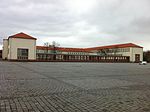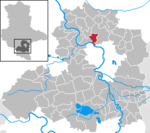Röt Formation
Anisian StageFossiliferous stratigraphic units of EuropeGeologic formations of GermanyLimestone formationsMudstone formations ... and 5 more
Paleontology in GermanyShale formationsShallow marine depositsTriassic GermanyTriassic System of Europe

The Röt Formation or Rötton Formation (German for Röt Shale), or Upper Buntsandstein, is a geologic formation of the Buntsandstein in Germany. It preserves fossils dating back to the Middle Triassic Epoch (Anisian or Aegean or Bithynian in the regional stratigraphy). The formation overlies the Plattenstein and Solling Formations and is overlain by the Jena Formation.The limestones, mudstones, shales and sandstones of the formation, deposited in a shallow marine environment, have provided fossils of early archosaurs, temnospondyls, fish and insects.
Excerpt from the Wikipedia article Röt Formation (License: CC BY-SA 3.0, Authors, Images).Röt Formation
Edlerweg, Halle (Saale) Dölau
Geographical coordinates (GPS) Address Nearby Places Show on map
Geographical coordinates (GPS)
| Latitude | Longitude |
|---|---|
| N 51.5 ° | E 11.9 ° |
Address
Edlerweg
Edlerweg
06120 Halle (Saale), Dölau
Saxony-Anhalt, Germany
Open on Google Maps




